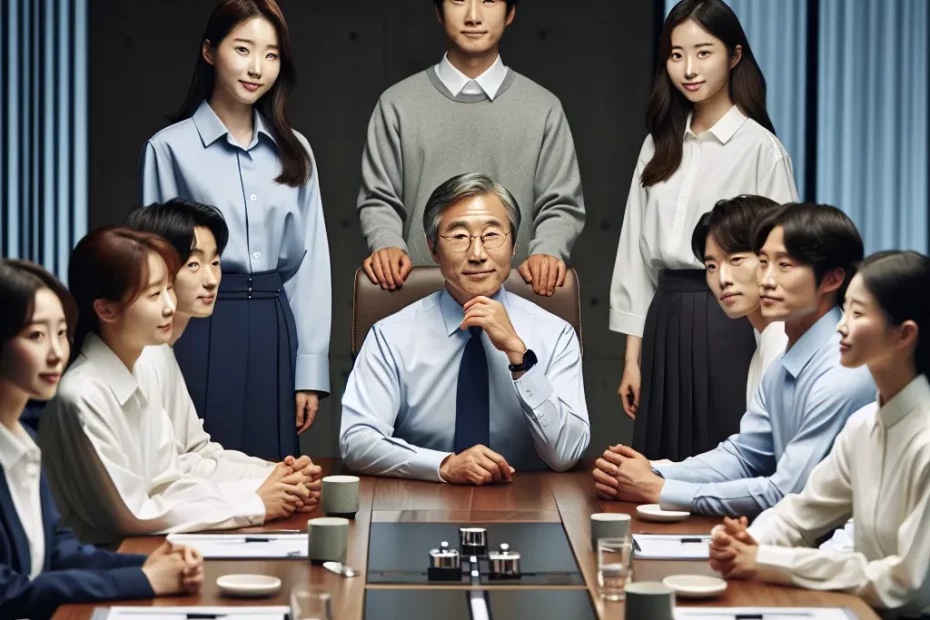In the dynamic world of Korean business culture, understanding hierarchical structures is key to navigating the professional landscape effectively. From the importance of titles and ranks to the nuances of communication dynamics, grasping these elements is crucial for successful collaboration in Korean workplaces. By delving into the intricacies of hierarchical boundaries, individuals can foster positive relationships, enhance teamwork, and achieve shared goals. Let’s explore how these hierarchical structures shape the Korean business environment and influence interactions among colleagues.

Overview of Hierarchical Structures in Korean Business Culture
In Korean business culture, hierarchical structures play a significant role in shaping organizational dynamics and communication patterns. This traditional system is deeply rooted in Confucian values, emphasizing respect for seniority, authority, and harmonious relationships within the workplace. Understanding the nuances of these structures is crucial for navigating the Korean business landscape effectively.
Hierarchy Levels:
Korean companies typically have a strict vertical hierarchy, with clear distinctions between different levels of authority. The top management holds the most power and decision-making authority, followed by middle managers, junior staff, and interns. Respect for authority and age is paramount, and individuals are expected to defer to those in higher positions.
Communication Channels:
Communication in Korean business settings often follows a top-down approach, where instructions and feedback flow from superiors to subordinates. Openly challenging or contradicting superiors is considered disrespectful and can disrupt harmony within the team. It is common for employees to use honorific language and formal speech when addressing those in higher positions.
Decision-Making Process:
Major decisions in Korean companies are typically made by senior management, with little input from lower-level employees. Consensus-building and group harmony are valued, and decisions are often reached through lengthy discussions and meetings. Understanding the underlying dynamics of decision-making processes is essential for employees at all levels.
Workplace Etiquette:
Respecting hierarchy extends beyond formal titles and positions. It also encompasses subtle gestures such as bowing, using appropriate language, and maintaining a respectful demeanor in all interactions. Building strong relationships with superiors and colleagues is essential for career advancement and success in Korean business culture.
In conclusion, hierarchical structures in Korean business culture play a vital role in shaping organizational behavior and communication norms. By understanding and respecting these structures, individuals can navigate the intricate dynamics of the Korean workplace with grace and professionalism.
Importance of Titles and Ranks in Korean Business Settings
In Korean business culture, titles and ranks play a crucial role in establishing hierarchy and maintaining order within organizations. The use of appropriate titles and showing respect for one’s position in the hierarchy is deeply ingrained in Korean society and is reflected in the way business interactions are conducted.
Titles and Ranks Reflect Status
Titles and Ranks Reflect Status: In Korean business settings, titles such as “team leader,” “manager,” or “director” not only indicate one’s position within the company but also reflect their status and authority. Addressing someone by their correct title is a sign of respect and acknowledgment of their position in the organizational structure.
Hierarchy in Decision-Making
Hierarchy in Decision-Making: The hierarchical structure in Korean companies influences decision-making processes. Seniority often plays a significant role in determining who has the final say in important matters. Younger employees are expected to defer to their seniors and follow their lead, creating a harmonious working environment based on respect for authority.
Formal Communication
Formal Communication: When communicating in a Korean business setting, it is essential to use formal language and address colleagues by their appropriate titles. Failure to do so can be seen as disrespectful and may lead to misunderstandings or strained relationships. Politeness and deference are highly valued in Korean business culture.
Promotion and Advancement
Promotion and Advancement: Advancement within a Korean company is often tied to one’s ability to navigate the hierarchical structure effectively. Demonstrating respect for senior colleagues, fulfilling one’s duties diligently, and showing loyalty to the organization are key factors in being considered for promotion. Titles and ranks serve as markers of progress and achievement.
Building Relationships
Building Relationships: Understanding the importance of titles and ranks is essential for building strong relationships in Korean business settings. By showing respect for hierarchy and acknowledging the authority of superiors, individuals can earn trust and credibility within the organization. This, in turn, paves the way for successful collaborations and partnerships.
In conclusion, titles and ranks hold significant importance in Korean business settings, shaping interactions, decision-making processes, and career advancement opportunities. By recognizing the significance of hierarchy and demonstrating respect for one’s position and that of others, individuals can navigate the intricacies of Korean business culture with grace and professionalism.
Communication Dynamics within Korean Workplace Hierarchy
Hey there, let’s dive into the fascinating world of Korean business protocol and explore the intricate communication dynamics within the workplace hierarchy. In Korean companies, hierarchical structures play a crucial role in shaping interactions and relationships among colleagues. Understanding these dynamics is key to navigating the corporate landscape in Korea with finesse and respect. So, buckle up and let’s unravel the nuances together! 🌟
The Role of Hierarchy in Korean Workplaces
In Korean workplaces, the hierarchical structure is deeply ingrained in the culture and reflects Confucian principles emphasizing respect for authority and seniority. This is evident in the use of honorifics and formal language when addressing superiors, creating a sense of order and harmony within the organization. 🎓
Non-Verbal Cues and Nuances
When communicating within the Korean workplace hierarchy, it’s essential to pay attention to non-verbal cues and subtle nuances. For example, bowing is a common form of showing respect, with the depth of the bow varying based on the seniority of the person being greeted. Additionally, maintaining eye contact at appropriate times demonstrates attentiveness and respect during conversations. 👀
Indirect Communication Style
Furthermore, the language used in Korean business communication is often indirect and relies heavily on context and understanding between colleagues. This can sometimes lead to a more nuanced and layered communication style, where reading between the lines is essential to grasp the full meaning of a conversation. 🗣️
The Importance of “Nunchi”
Another important aspect of communication within the Korean workplace hierarchy is the concept of “nunchi,” which refers to the ability to gauge the emotions and intentions of others through subtle cues. Developing strong nunchi skills can help navigate office politics and build stronger relationships with colleagues at all levels of the hierarchy. 🧠
Conclusion
In conclusion, mastering the communication dynamics within the Korean workplace hierarchy is essential for success in the corporate world in Korea. By understanding and respecting the hierarchical structure, using appropriate language and non-verbal cues, and honing nunchi skills, you can navigate the complexities of Korean business culture with confidence and grace. Cheers to building strong relationships and thriving in the dynamic Korean workplace environment! 🌸
Navigating Hierarchical Boundaries for Effective Collaboration
In the dynamic landscape of Korean business culture, understanding and navigating hierarchical structures is essential for successful collaboration. 🌟 From the traditional emphasis on seniority to the modern blend of hierarchy and teamwork, Korean businesses operate within a unique framework that requires finesse and adaptability. Let’s delve into the nuances of hierarchical boundaries in Korean workplaces and explore strategies for fostering effective collaboration across different levels.
Hierarchy in Korean Business Settings
Hierarchy in Korean business settings is deeply ingrained, with titles, positions, and age playing significant roles in determining authority and decision-making power. 🏢 Respect for seniority is a cornerstone of Korean corporate culture, where younger employees are expected to defer to their seniors in both speech and actions. This vertical structure can sometimes lead to challenges in communication and decision-making, especially for those accustomed to flatter organizational hierarchies.
Shift Towards Collaboration and Teamwork
Despite the hierarchical nature of Korean businesses, there is a growing trend towards a more horizontal approach that values collaboration and teamwork. 🌱 Younger generations entering the workforce are bringing fresh perspectives and a willingness to challenge traditional norms, leading to a shift towards a more egalitarian workplace culture. This blend of hierarchy and collaboration presents both opportunities and challenges for effective teamwork and innovation.
Strategies for Effective Collaboration
To navigate hierarchical boundaries for effective collaboration in Korean business settings, it is crucial to strike a balance between respect for authority and fostering open communication. 🌟 Building strong relationships with colleagues across different levels of the hierarchy is key to creating a harmonious work environment where ideas can flow freely. By acknowledging and respecting the expertise and experience of senior colleagues while also encouraging diverse perspectives from all team members, teams can leverage the strengths of both hierarchical and collaborative approaches.
Understanding Formalities and Protocols
In addition to interpersonal relationships, understanding the formalities and protocols associated with hierarchical structures is essential for navigating Korean business culture. 🎓 From using appropriate honorifics in speech to observing proper etiquette in meetings and presentations, demonstrating respect for hierarchy through actions and words is paramount. By mastering these cultural nuances and adapting to the hierarchical dynamics of the workplace, individuals can build trust, credibility, and rapport with colleagues at all levels.
Embracing the Richness of Korean Business Culture
Effective collaboration in Korean business settings requires a nuanced understanding of hierarchical boundaries and a willingness to adapt to the evolving nature of organizational structures. 🚀 By embracing the traditional values of respect for authority while also fostering a culture of teamwork and innovation, individuals can navigate hierarchical structures with confidence and contribute to successful collaboration in the dynamic world of Korean business. Let’s embrace the richness of Korean business culture and leverage hierarchical structures for effective collaboration and growth! 🌟
In conclusion, understanding the hierarchical structures in Korean business culture is essential for effective communication and collaboration in the workplace. By recognizing the importance of titles and ranks, individuals can navigate the dynamics of the Korean workplace hierarchy with respect and clarity. Building relationships and fostering teamwork within this framework can lead to successful outcomes and mutual understanding. Remember, embracing these cultural nuances can open doors to new opportunities and strengthen professional relationships. Keep an open mind, show willingness to learn, and adapt to the cultural norms for a more harmonious and productive work environment. Embrace the hierarchical structures as a way to enhance communication and foster collaboration, ultimately leading to success in the Korean business landscape.
